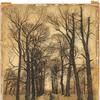Houston's Moody Center for the Arts Readies for Launch - Debuts Experimental Platform Intertwining Arts, Sciences and Humanities
- HOUSTON, Afghanistan
- /
- January 24, 2017
The New $30 Million Noncollecting Art Institution Was Built Specifically for Interdisciplinary Collaboration; Opens Feb. 24
Highlights in Winter‐Spring 2017 Include the First U.S. Realization of Olafur Eliasson’s Green light Project, an Exhibition of Thomas Struth’s Photographs of Scientific Research, a Site‐Specific Dance Performance by Dušan Týnek Dance Theatre at the James Turrell Twilight Epiphany Skyspace and On‐Campus Events with Moody Artist‐in‐Residence Mona Hatoum
Alison Weaver, the Suzanne Deal Booth Executive Director of Rice University’s Moody Center for the Arts, has announced a wide‐ranging international program that will inaugurate this new transdisciplinary lab for creativity, opening to the public Feb. 24, 2017, in Houston. The striking architectural design for the 50,000‐square‐foot, $30 million Moody is by Los Angeles-based Michael Maltzan Architecture. Michael Maltzan’s design, with its bold geometric shapes and inviting transparency, makes the Moody a beacon on Rice’s campus while affirming the mission to foster connections across disciplines.
Among the first noncollecting art institutions built specifically for interdisciplinary collaboration, the Moody is conceived as an experimental platform for creating and presenting works of all kinds — a place where new modes of making can flourish in flexible teaching spaces, and visitors can engage with artists from around the country and the world.
From February 24 through mid‐May 2017, the Moody will be filled with projects, works and events by artists including Olafur Eliasson, Thomas Struth, Diana Thater, inaugural artist‐in‐residence Mona Hatoum, the Tokyo‐based digital “ultra‐technologists” of teamLab, and New York City’s Dušan Týnek Dance Theatre.
The Inaugural Season
The Central Gallery of the Moody will be the site for the first installation in the United States of Olafur Eliasson’s Green light — An artistic workshop. Initiated by the Danish‐Icelandic artist in March 2016 in collaboration with Thyssen‐Bornemisza Art Contemporary (TBA21) in Vienna, Green light addresses the international refugee crisis and the ongoing phenomenon of economic migration both metaphorically and practically.
Green light testifies to Eliasson’s belief in the agency of contemporary art and its potential to initiate processes of civic transformation. On a metaphoric level, the project gives the green go‐ahead light to asylum seekers, refugees, and economic migrants by inviting them to participate in an extensive multi‐faceted program of shared learning. This includes a workshop for the construction of stackable, modular green lamps, designed by Eliasson and made from recycled and sustainable materials, as well as language courses, seminars, artist’s interventions, screenings, and other initiatives that respond to the needs of the participants. The proceeds of the sale of Green light lamps will be donated to partnering non‐governmental organizations that assist refugees and migrants.
An integral component of the project is that University students and members of the public are invited to join the refugees and migrants in this collaborative process of artistic fabrication and learning, creating a space for exchange and encounter between people from different geographic, social, economic, linguistic, and educational backgrounds. As an educational and creative center located in Houston, now one of the most diverse cities in the United States, the Moody is especially suited to host Green light — An artistic workshop and the public discussions that the project aims to generate. The Moody’s partner organization will be the non‐denominational Interfaith Ministries of Greater Houston.
The premier art exhibition space of the Moody, the Skylight Gallery, will present Nature & Politics, featuring recent large‐scale photographs by Thomas Struth. Based on an exhibition that was co‐ organized by the Museum Folkwang in Essen, Martin‐Gropius‐Bau in Berlin and the High Museum in Atlanta, the Moody’s presentation will concentrate on Struth’s monumental images of sites of scientific research and manufactured landscapes.
The photographs bear witness to very specialized imaginations: whether it is the technological developments that made space travel possible, experiments in plasma physics or industrial facilities such as offshore oil rigs or blast furnaces — all owe their existence to the ideas and designs of experts. The artist will be present for a panel discussion during the opening weekend, when the Moody will inaugurate interdisciplinary conversations about technology and research — important and timely topics of global significance — and how our experience of them shapes our perceptions of the world.
The Reception Gallery at the Moody, which welcomes visitors into the building, will pay tribute to Houston’s renowned as the site of NASA’s mission control with an installation of The Starry Messenger (2014), a nine‐monitor video wall by artist Diana Thater. This spectacular and encompassing work presents a changing vista of the Milky Way filmed in the Griffith Observatory Planetarium in Los Angeles, shot from below the massive Zeiss star projector. In partnership with the Rice Space Institute, the work will be at the center of a series of cross‐disciplinary conversations about the technology of space exploration and the impact it has on life on Earth.
In the Moody’s two Media Arts Galleries, visitors will encounter interactive digital works by the Tokyo art collective teamLab, including Flowers and People, Cannot be Controlled but Live Together — A Whole Year per Hour (2015). Immersive and hypnotic, their large‐scale installations consist of CG visuals that change at the visitor’s touch, releasing constantly evolving images of natural forms in an interplay of art, digital technology and the human presence.
In the Moody’s Studio Theater, the innovative Dušan Týnek Dance Theatre will conduct a weeklong residency during the Moody’s opening. The residency will result in two to three site‐specific dance performances, presented between February 24 and 26, in response to the James Turrell Twilight Epiphany Skyspace nearby on the Rice campus with live choral music performed by an ensemble from Rice’s outstanding Shepherd School of Music.
A talk with artistic director/choreographer Dušan Týnek about his creative process and interest in James Turrell’s work will take place at the Moody during the opening weekend. Other presentations that will follow in the Performance Space include a production of Proof by David Auburn, in collaboration with Rice’s departments of Visual and Dramatic Arts and Mathematics, and a performance of Lisa Peterson and Denis O’Hare’s An Iliad, with original music composed and performed by students from the Shepherd School.
The Moody is proud that its first artist‐in‐residence will be Mona Hatoum, the internationally acclaimed Beirut‐born Palestinian artist whose work in sculpture, performance, video and installation was recently the subject of a major survey exhibition at London’s Tate Modern. Underscoring the Moody’s collaborative goals within Houston’s rich cultural scene, Hatoum will devote her residency in part to developing works for a major exhibition, her first in the United States in 20 years, at the Menil Collection Oct. 6, 2017 ‐ Feb. 25, 2018. Hatoum will appear, together with scholars from diverse fields, in a panel discussion about her work and will participate in a sculpture class at Rice’s Department of Visual and Dramatic Arts.
Rounding out the schedule of activities housed in the Moody will be five new interdisciplinary courses developed for Rice undergraduates. Information on these evolving courses, developed under the rubric of “art plus.” Information on these evolving courses is available at https://moody.rice.edu/.







![Peter Paul Rubens (Flemish, 1577–1640), After Titian (Tiziano Vecelli) (Italian [Venetian], c. 1488–1576), Rape of Europa, 1628–29. Oil on canvas, 71 7/8 x 79 3/8 in. Peter Paul Rubens (Flemish, 1577–1640), After Titian (Tiziano Vecelli) (Italian [Venetian], c. 1488–1576), Rape of Europa, 1628–29. Oil on canvas, 71 7/8 x 79 3/8 in.](/images/c/e2/2e/Jan20_Rape_of_Europa100x100_c.jpg)




![Offering a Truce [Bested], 1895, is estimated to sell for between $1,300,000 and $1,800,000 on March 22, 2014, for The Russell: An Exhibition and Sale to Benefit the C.M. Russell Museum. Offering a Truce [Bested], 1895, is estimated to sell for between $1,300,000 and $1,800,000 on March 22, 2014, for The Russell: An Exhibition and Sale to Benefit the C.M. Russell Museum.](/images/c/a8/20/Dec10_Offering_a_Truce__Bested_300dpi100x100_c.jpg)

